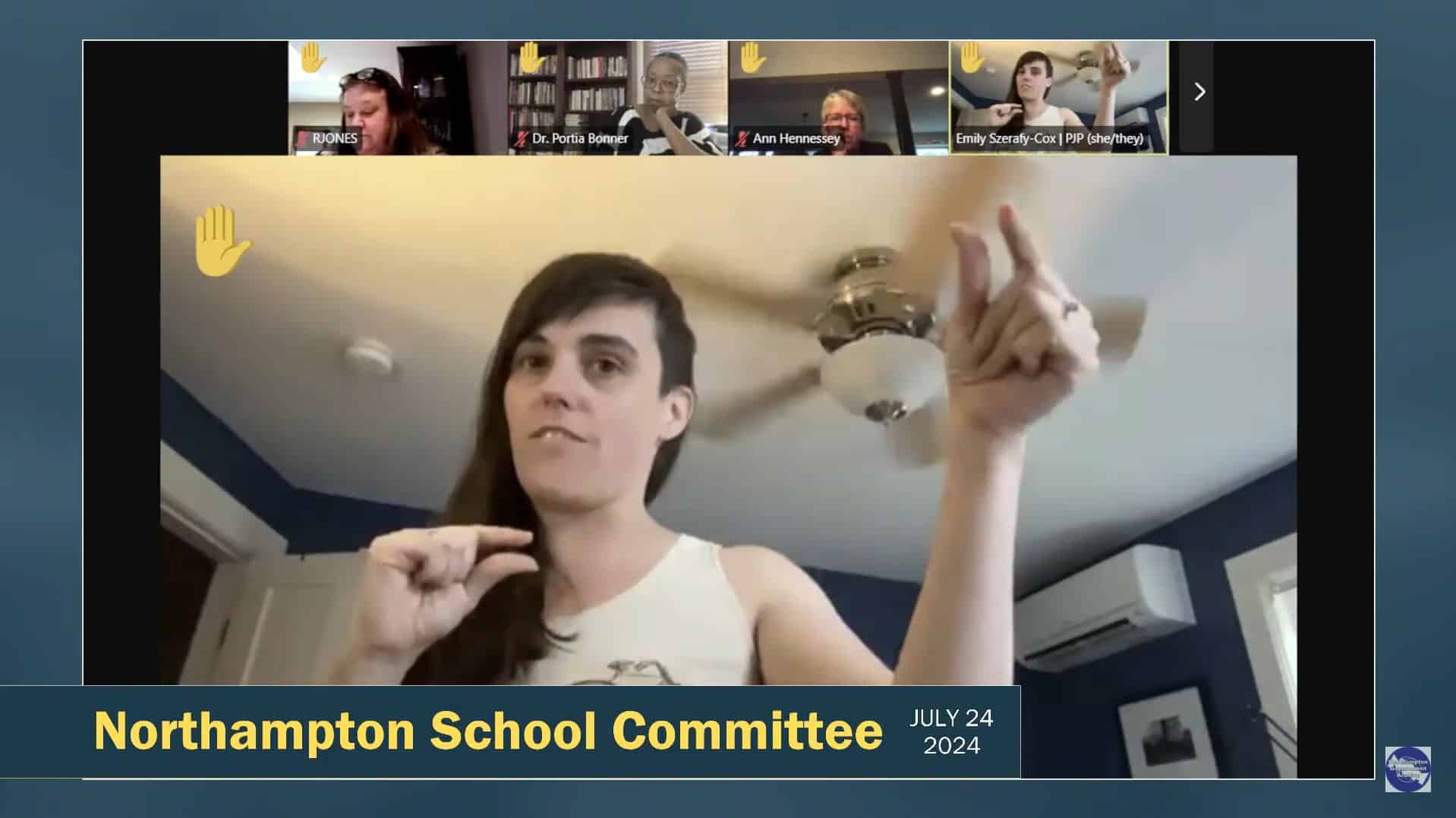Committee member Emily Serafy-Cox presents an alternate plan for restoration of student facing positions in the district.
Photo credit: Northampton Open Media
NORTHAMPTON — In what was ostensibly the final discussion around the fiscal year 2025 budget, the Northampton School Committee failed to pass a motion made by a School Committee member that would have redirected some of the current cuts in the school budget to less student-facing positions in the district.
The school budget for FY25, which officially started on July 1, is $40.8 million, or an 8% increase from FY24. The original school budget that passed on July 1 was $39.6 million, but the City Council approved additional appropriations from Mayor Gina-Louise Sciarra’s budget to get to that $40.8 million a few days after.
The approval of the school budget ended what was a contentious several months of the budget season where advocates across the school district, different unions and other sectors of the community pushed for the approval of a level services budget to avoid cuts.
With the $40.8 million passed, around 22 positions in the district will be cut, including 19 full-time positions and three part-time positions.
The cuts include the elimination of a first grade paraeducator, a school year clerk and a math interventionist at Bridge Street Elementary School; a first grade paraeducator and a grade level teacher at Jackson Street Elementary School; and a first grade paraeducator, a special education teacher, a grade level teacher and a math interventionist at Leeds Elementary School.
The budget also includes the elimination of a first grade paraeducator and a special education teacher at Ryan Road Elementary School; a physical education teacher, a Spanish teacher, a tech integration specialist, a math interventionist and a math coach at JFK Middle School; and a school year clerical worker, an English teacher and an adjustment counselor at Northampton High School.
“I’m very concerned about all of these cuts, and I just want to acknowledge that we are in the land of bad choices,” said Ward 4 School Committee member Michael Stein, after reading off the cuts during a special meeting of the School Committee on July 24. “All of these positions are valuable.”
Although the school budget was already passed, the committee spent most of the special meeting discussing the impacts of the cuts on the district in what was an emotional two-plus hours of deliberation.
Ward 3 member Emily Serafy-Cox presented an alternative plan to the committee during the meeting that would have restored several positions and redirected cuts to less student-facing positions.
Their alternate plan proposed the restoration of the first grade paraeducator and math interventionist at Bridge Street; a math interventionist position and a 0.5 library paraeducator at Leeds; a 0.5 library paraeducator at Ryan Road; a math interventionist at JFK; and an English teacher and adjustment counselor at the high school.
Serafy-Cox’s proposal also included a $50,000 reduction in the district’s business office, the elimination of the family engagement coordinator position and director of curriculum position, as well as the elimination of the gateway to college and dual enrollment programs at the high school.
They also proposed that more money from the special education stabilization fund be used to cover expenses in the budget. Right now, the budget includes a little over $200,500 from that fund.
“As I’ve stated since the beginning of this process, my priority was for student-facing positions, and that’s what I am hearing from our constituents,” Serafy-Cox said. “I offer this motion as changes to the budget that has already been approved as a way to exercise that prioritization a little differently than the current budget does.”
Despite the attempt to redirect the cuts away from the current positions that are being cut, the motion was shot down 6-2, with only Serafy-Cox and Stein the only members to support the alternate proposal.
“I couldn’t vote yes because I didn’t agree with the whole package,” said Ward 6 member Margaret Miller, regarding Serafy-Cox’s proposal. ”If I have some further thoughts, I will communicate with the superintendent and tell her other ideas I may come up with. But as of right now, I could not vote yes because I could not agree with all of that.”
In response to Serafy-Cox’s proposal, Superintendent Portia Bonner made the argument that all of the alternative cuts that Serafy-Cox proposed were important to maintain for various reasons.
Although they were funded by ESSER funds, Bonner said that there was a recommendation to maintain the gateway and dual enrollment programs at the high school because they offered a “unique way” to provide access to college bound courses. She also said that cutting the programs would be inequitable since the majority of students who participated were low-income students of color and IEP students.
Bonner also argued that losing the director of curriculum position would affect curriculum work and the district’s ability to close academic gaps and meet the changing standards and needs of students.
She also said that it is important to not make reductions in the business office since there is a transition currently happening where three individuals in the department are retiring while others are being trained.
“Although these positions you listed are beyond the classroom, they impact the classroom,” Bonner said, regarding the alternate proposal.
Bonner also added that it would not be appropriate to add more special education stabilization fund money to the budget since the positions Serafy-Cox proposed to restore did not have much to do with special education.
“So, for instance, a math interventionist is someone who helps from tier one all the way to tier three,” Bonner said. “So, it’s not just germane to special education.”
Things got testy during the meeting when Stein called a point of information to argue that the special education stabilization fund money that is already part of the budget is being used for things outside of special education.
“The money we’re taking from [the special education fund] is literally just Medicaid reimbursement we’re using for our regular budget, not for special education,” Stein said.
According to Bobbie Jones, the business director for the district, the Special Education Stabilization Fund can be used in the general fund budget up to the amount that the city has in the Medicaid reimbursement from the previous year as well as for extraordinary unforeseen expenses relating to special education.
Many committee members during the meeting lamented the situation the district finds itself in when it comes to the cuts that need to be made. A couple members liked Serafy-Cox’s idea of restoring the English teacher position at the high school rather than the dual enrollment and gateway programs, but some members could not get behind everything Serafy-Cox proposed.
Ward 7 member Kerry LaBounty said she voted no on Serafy-Cox’s proposal because she thought the committee would vote on the proposal line by line rather than vote on the entire package.
“There are things that I really agreed with, but I’m not sure I agreed with the whole thing,” said Ward 7 member Kerry LaBounty, regarding Serafy-Cox’s proposal.
Ward 5 member Ann Hennessey said that she does not agree with all of the cuts presented by the superintendent, but she instilled her trust in Bonner to look at the district as a whole.
“If you were to give me an intellectual exercise to defend each position, I could do that because they’re all that important,” Hennessey said. “It’s a terrible choice but I think it is the role of our superintendent who’s just been here for about a year to look at the district as a whole, to look at each school as an ecosystem.”
In closing remarks, At-Large School Committee member Gwen Agna said she is concerned that people may be coming away from this budget season thinking that the majority of the members on School Committee do not advocate for students based on how the voting went down.
“It’s very hurtful and sad,” Agna said, referring to that notion from some community members. “I hope that we can find a way to come together and not be vilified and not be accused of being not on the side of children.”
Overall, there was no appetite to continue a discussion around these cuts at a future meeting. Bonner said a decision needed to be made during the special meeting since the district is revving up for the upcoming school year.
“Tonight was our last chance; it’s done; I’m really disappointed,” Serafy-Cox said.



